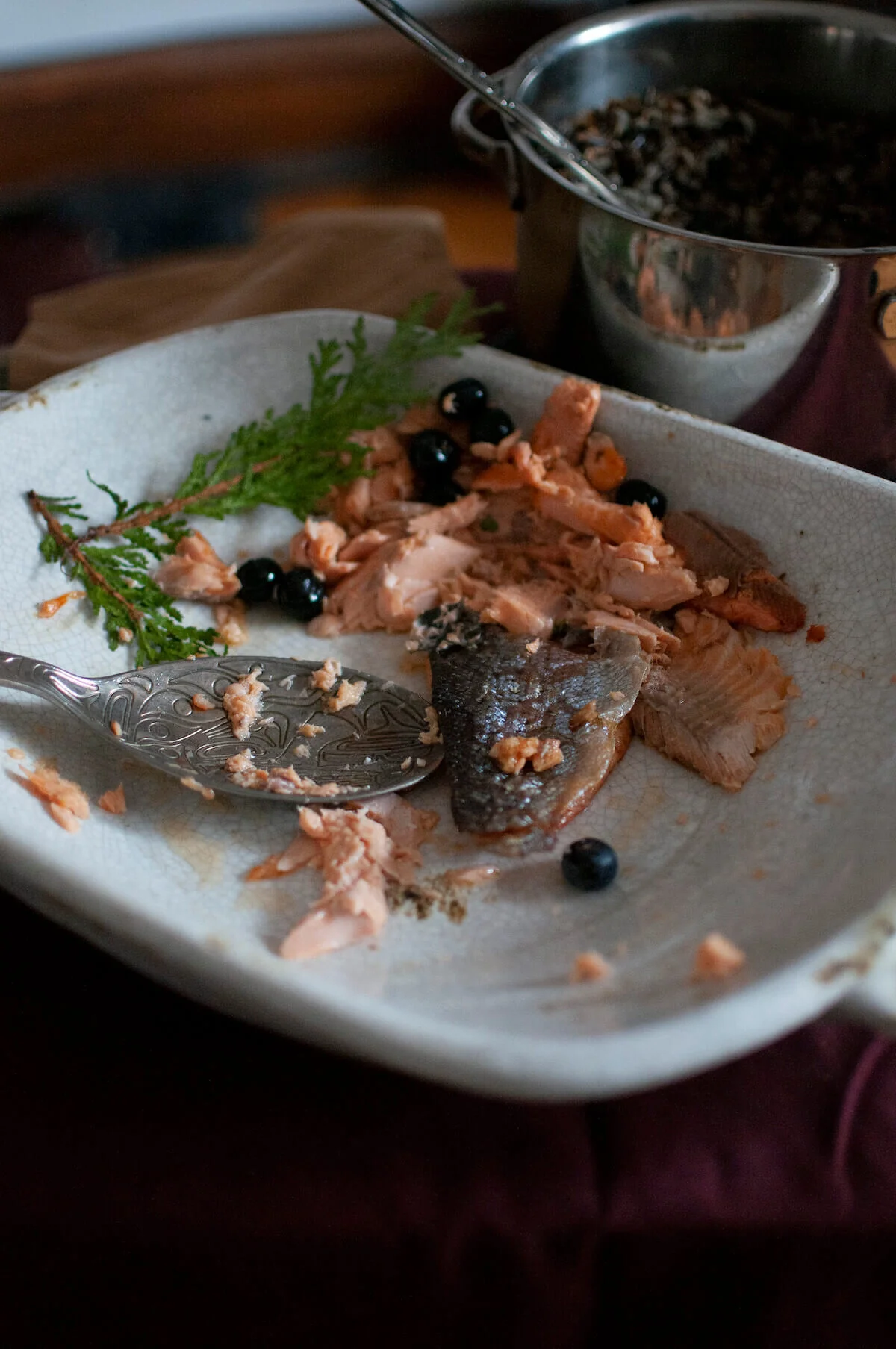IN CATHERINE'S KITCHEN
FROM DECEMBER 2019 ISSUE OF WEST END PHOENIX
“These things are deep within you. You just have to awaken to them”
Catherine Tammaro, who grew up Irish-Italian, never understood what drew her to the ceremonies she observed when she was younger – crushing berries for face paint, lining her path in cedar boughs, drumming by the High Park burial mounds – until she discovered her mother was adopted and that another culture had been waiting for her to find it
As a child, Catherine Tammaro was often compelled to acts that she couldn’t explain or resist.
She grew up Irish-Italian in Toronto’s West End, daughter to Frank and Dorothy Tammaro. At five years old she discovered pyracantha berries and crushed them into pulp to paint her face, one mark on each cheek. Later she would forage in the woods and parks of Toronto, California and Ohio, as the family moved with her father’s job.
“I used to draw patterns over and over and over again. I’d tattoo my legs with magic markers in these designs. Let’s just say these were not inconsistent with ceremonial practices. It could be labelled as blood memory, ancestral memory,” she explains.
There is something professorial about Tammaro. She is deeply thoughtful and her knowledge about art, history and politics is almost intimidating. At the same time, she is warm and engaging, embodying all the best attributes of a storyteller.
Catherine’s sun-filled apartment looks out over a leafy and dappled street lined with red brick houses. Families with baby carriages stroll by, in the suburban quiet, only blocks away from choked intersections. From her living room, there’s a view through an old oak door of a Buddha head on her tranquil balcony.
Catherine has made cornbread, a recipe she perfected over the years with her husband, Phil Ogison, who was a composer, woodworker and lyricist. She has also seared rainbow trout until the skin crisps golden; she brings this out to the table on a thick pottery platter. There is wild rice studded with dried cranberries, and acorn squash baked with maple syrup and butter. Catherine admits she doesn’t usually cook a spread like this for lunch, but today is special. Today we are talking about how she found herself.
For a time she lived near the lake, in an apartment building at King and Beaty. Her bedroom faced onto the back alley. “There was a lot of action back there. Sometimes I’d sense shadows moving past my bedroom window. I never really felt safe.” She sensed what she describes as a residual energy back there – “echoes of unknown incidents, like some shifty downtown thing. It didn’t feel quite right.” She pours us cups of hot cedar tea. “I was forever burning temple incense outside my back door, trying to alter the spooky vibes.”
A friend of hers was pruning his cedar trees and Catherine asked for the trimmings. “I didn’t know why, I just had to have them.” Her friend brought six garbage bags of the branches and boughs. “I carpeted the laneway from King Street all the way to the back end of my apartment. It was this soft carpet of cedar and it changed the vibe back there completely.”
She sets a plate of cornbread, garnished with cedar and tumbled with plump blueberries, on the table. “It was either a huge piece of installation art or some sort of spiritual reclamation of the space. It felt much better for a long time.”
Her family moved to Cupertino, California, when she was eight and then to the Tanglewood Lake Housing Development in Ohio at 12. In California, Catherine found out that her mother, Dorothy, had been adopted. “My world was shattered. My mother was from a wellknown family in London, Ont., and I grew up thinking I was Irish.” She remembers pony rides and family gatherings at the summer house in Port Stanley. “Learning that they weren’t my family – that was very difficult.”
During this time Catherine had a conversation and a visitation that have stuck with her ever since. The first took place at home. She laid her arm down beside her father’s at the dining room table. “My skin is a different colour than yours. Why?” I said, “I know we’re not white.”
“Of course we are,” he replied. “What are you talking about?”
“We are not white. You can’t talk me out of it.”
Several years later, when she was in Grade 12, her family was visited by a giant white snowy owl, perched on the tree outside their window. They were watching TV but the sight of the owl grabbed everyone’s attention and they were transfixed. “It was beautiful. Everybody froze.” The next day her mother began in earnest to seek out her birth family.
“She was born at St. Joseph’s in London,” Catherine says. The records have deteriorated, and that’s all the information that remains.
Dorothy took up pottery. “She bought a 4,300-pound kiln. My father had to move a wall in the garage to accommodate it.” In the garage Dorothy fired owl sculptures.
After high school Catherine moved back to Toronto, and began her own work as an artist – as a painter, photographer and illustrator. She found herself drawn to High Park. There she joined a drumming circle and met David Redwolf, who was the executive director of the Taiaiako’n Historical Preservation Society.
She told him, “I’m not paranoid and I don’t have any psychiatric disorders but I often feel like I’m being followed down the street.”
He pointed to the area where the drumming circle met. “That’s a funeral mound,” he told her. “The ceremony that you’re doing is connecting with that spiritual energy.”
Not long after the conversation with Redwolf, Catherine woke up in the middle of the night to see a woman standing at the foot of her bed.“I didn’t see it from here,” she points to her dark brown eyes behind funky black glasses. “I saw it from here,” and points to the middle of her forehead.
So she did what one does when this kind of thing happens. She called a clairvoyant. The clairvoyant came to the apartment and looked around and said, “Oh, your grandmother’s here.” But the woman had looked nothing like NuNu Tammaro.
“Not your Italian grandmother,” said the clairvoyant. “Your other grandmother.” Then she patted Catherine’s arm and said, “Don’t worry. In about 15 years everything will become clear to you.”
Fifteen years later, Catherine found someone who seemed to be connected to Dorothy’s birth mother – a woman named Judith, who was the genealogist for the Wyandot Anderdon Nation. With her mother by her side, Catherine called Judith and shared what meagre information they had about Dorothy’s background. Judith responded, “We’ve been waiting for you for over a hundred years.”
Dorothy could not have known this as her husband demolished a wall in their Tanglewood garage to fit her mammoth kiln, but Wyandot women are great potters. The designs that Catherine had tattooed on her legs as a child, she says, resembled traditional Wyandot patterns.
“Phil understood its tremendous significance for me from a spiritual perspective,” she says. “I had been searching for my authentic ancestry forever. We both believed that these things are already deep within you. Of course, you just have to awaken to them.”
Now Catherine is a seated Tradition Keeper for the Wyandot of Anderdon Nation, Speckled Turtle Clan, and she is the inaugural Indigenous Elder in Residence for Akin Collective, a Toronto-based arts organization. Her Wyandot name is Taǫmęˀšreˀ and her clan is date:žátǫ ngyaˀwiš hatiyerunǫˀ, which translates to People of the Little Turtle.
Buddha keeps vigil on her patio, A turtle shell hangs by the window in her studio among her many oil paintings, and there’s a bundle of cedar on the kitchen counter. On her fireplace mantel is a small figure of a snowy owl beside a portrait of Phil, who died from cancer last fall. Catherine sits in the heart of her home, radiating peace.
“It’s all part of who I am.”
Cath & Phil’s currant cornbread
Makes one pan
wet ingredients
⅓ cup olive oil
1 cup whole milk
1 tsp pure vanilla
1 egg
maple syrup to taste (about ⅓ cup; has to be real maple syrup)
1⁄2 cup dried currants
dry ingredients
1 cup fine cornmeal (plus a few tbsp to coat pan)
1 cup organic whole wheat flour
4 tsp baking powder
1⁄4 tsp salt
method
Combine wet ingredients in a large bowl. Mix dry into wet and stir until it is smooth, with a consistency like cake batter. Grease a 9-in. cast iron pan with butter. Sprinkle cornmeal lightly all over pan, including sides. Bread should be easily removable from pan once baked.
Bake at 350ºF for 36 minutes. It’s done when a toothpick inserted in centre comes out clean. Let cool slightly, then cut into wedges or squares.
Pile pieces on plate for a studied casual arrangement. Shove cedar twig in for extra beauty factor; drop some blueberries around the stacked pieces for colour.
Let cool, then squeeze a little lemon juice on top, and with a sieve dust the top generously with icing sugar.




